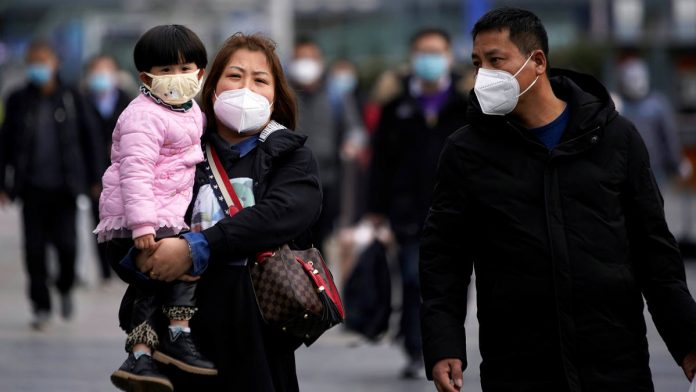WHAT WE HAVE ON THIS PAGE
- Editor’s Choice
- Dark Web Activity Breakdown by Category
- Number of Active Dark Web Marketplaces
- Cryptocurrency Usage Trends on the Dark Web
- Key General Facts About the Dark Web
- Estimated Revenue Generated via Dark Web Activities
- Dark Web and Cybercrime Correlation
- Largest Dark Web Marketplaces by Share
- Law Enforcement Takedowns and Arrest Rates
- User Demographics and Geographic Distribution
- Dark Web Intelligence Market Growth Forecast
- Dark Web’s Share of Global Internet Traffic
- Impact of AI and Emerging Tech on Dark Web Operations
- What You Can Find on the Dark Web
- Notable Dark Web Data Breaches and Leaks
- Where Funds Go After Leaving Darknet Markets
- Recent Developments in Dark Web Monitoring
- Conclusion
- Sources
It started in whispers, in hacker forums and encrypted chat rooms. Back then, the dark web was a niche curiosity for cyberpunks and tech rebels. Fast forward to 2025, and it’s a vast, digital underworld humming beneath our internet’s surface. While most of us browse websites with a few clicks, there’s an entire hidden ecosystem where anonymity reigns and commerce thrives, often illegally.
This article dives deep into 2025 dark web statistics, offering a clear, data-driven view of what’s happening below the surface. From the rise of crypto-fueled markets to AI-augmented cybercrime, the numbers paint a vivid picture of a space that’s expanding faster than most can monitor.
Editor’s Choice
- As of early 2025, there are over 37 active dark web marketplaces.
- Around $3.2 billion in total annual revenue is estimated to be flowing through dark web platforms.
- 60% of illicit transactions on the dark web now involve privacy coins like Monero, up from 45% last year.
- Over 68% of dark web market vendors ship illicit goods to North America, making it the top regional destination.
- Artificial intelligence is now used in over 35% of phishing kits sold on dark web forums.
- 17 million users globally accessed dark web services at least once in the first quarter of 2025.
- Law enforcement has seized six major marketplaces in the past 12 months, disrupting over 120,000 user accounts.
Dark Web Activity Breakdown by Category
- Illegal file sharing dominates the dark web, accounting for 29% of all content. This includes unauthorized distribution of copyrighted materials and pirated software.
- Leaked data follows closely at 28%, highlighting the significant volume of stolen credentials, databases, and private information traded on the dark web.
- Financial fraud represents 12% of dark web content. This includes phishing kits, stolen credit card data, and banking scams.
- News media appear in 10% of dark web activity, indicating the presence of underground journalism or access to censored content.
- Promotional content makes up 6%, likely used to advertise dark web services, tools, or forums.
- Discussion forums account for 5%, providing anonymous spaces for users to exchange illicit information or coordinate activities.
- Drugs represent 4% of dark web content—surprisingly lower than expected, possibly due to tighter enforcement and migration to other platforms.
- Hacked accounts make up 3%, showing that user credentials and account access are still actively traded commodities.
- P*rnography appears in 1%, reflecting strict regulation or shifting user behavior.
- Weapons are the least common, comprising only 0.3% of dark web content, though still a critical concern for law enforcement.
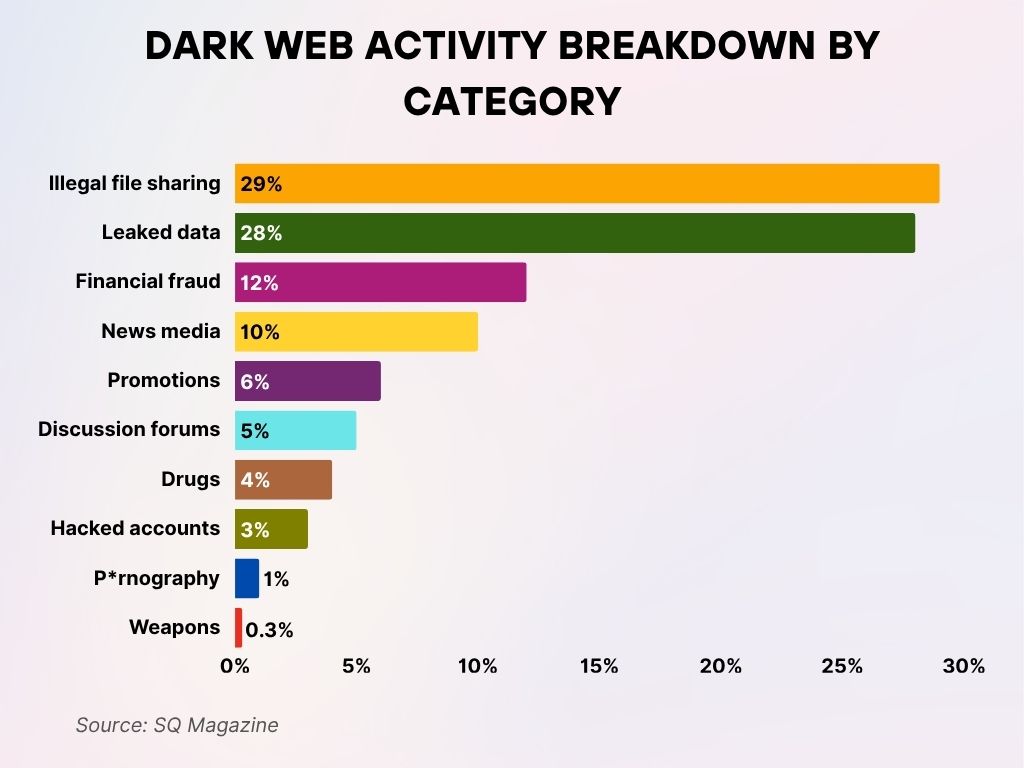
Number of Active Dark Web Marketplaces
- In Q2 2025, there are 37 known active marketplaces, showing a 28% year-over-year increase.
- The top five markets account for nearly 72% of all transactions.
- Newer platforms are emerging every 3-4 weeks, despite frequent takedowns.
- 20% of these marketplaces specialize exclusively in data and identity theft services.
- 4 major markets launched in 2025 focus entirely on digital tools like ransomware kits and AI scrapers.
- Marketplace turnover remains high: the average lifespan is now 7.5 months.
- Encrypted mobile-friendly markets now represent 22% of all traffic, aligning with increased mobile Tor usage.
Cryptocurrency Usage Trends on the Dark Web
- In 2025, Monero (XMR) is used in 60% of transactions, displacing Bitcoin as the top currency.
- Bitcoin (BTC) still holds strong with a 30% transaction share, primarily due to broader vendor support.
- Emerging altcoins like Zcash and Dash represent a combined 5% of dark web transactions.
- Ethereum-based tokens are growing in niche usage, especially in fraud-as-a-service circles.
- Vendors now prefer privacy-enhancing wallets; over 40% use mixers and tumblers to obscure payments.
- Average transaction value has risen to $624, up 11% from last year.
- Nearly 20% of vendors offer dynamic crypto pricing, adjusting for market volatility in real-time.
Key General Facts About the Dark Web
- The Dark Web makes up an estimated 5% of the total internet. Despite its small size, it hosts a significant amount of illegal and anonymous content.
- The Deep Web accounts for up to 99% of the entire internet. This includes unindexed pages like academic databases, private networks, and password-protected content.
- 70% of people globally don’t understand how the Dark Web works, indicating a widespread knowledge gap about its structure and risks.
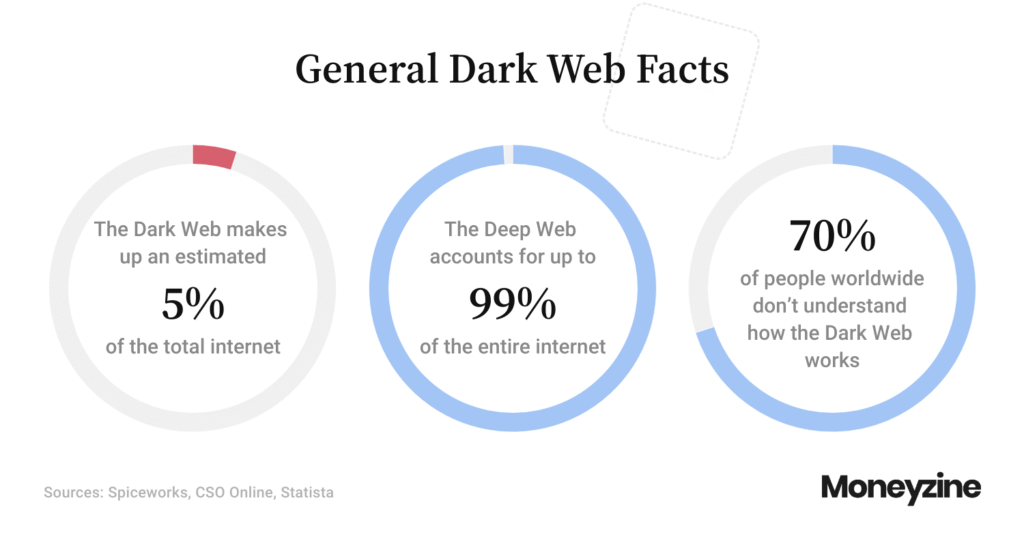
Estimated Revenue Generated via Dark Web Activities
- In 2025, dark web-related activities are estimated to generate $3.2 billion globally.
- Of that, $1.1 billion comes from illicit drug sales alone.
- Fraud and scam services account for an estimated $520 million in annual earnings.
- Cybercrime-as-a-service platforms, offering tools like ransomware kits or phishing templates, contribute $700 million.
- Weapon trafficking and counterfeit document markets together represent approximately $250 million in revenue.
- Profits from hacked database sales have surged, with dark web data brokers earning over $430 million in 2025.
- The average vendor earns about $12,700 annually, while top-tier operators exceed $400,000 per year.
- The US alone contributes nearly 30% of transactional volume, followed by Russia and Germany.
Dark Web and Cybercrime Correlation
- Over 78% of ransomware strains identified in 2025 have a known dark web distribution origin.
- Digital black markets now serve as launch pads for 41% of large-scale cyberattacks, including critical infrastructure breaches.
- Phishing kits and social engineering services sold online have been linked to 65% of credential stuffing attacks this year.
- Money laundering services, often tied to cybercrime, account for a growing $120 million economy on the dark web.
- Nearly 70% of financial fraud operations investigated by international law enforcement had links to dark web vendors.
- Dark web forums increasingly serve as recruitment grounds for novice cybercriminals.
- A new trend in AI-generated scam pages is rising, with over 11,000 kits sold in Q1 2025.
- Telegram and Discord channels affiliated with dark web forums have also doubled in user base, expanding coordination.
- BlackSprut Market leads all dark web marketplaces with a dominant 28% share. It’s recognized for its wide product variety and active user base.
- Mega Darknet Market follows with 22%, known for offering illicit goods ranging from stolen data to counterfeit documents.
- OMG! OMG! Market holds 17% of the market. It’s a rising platform gaining traction for ease of access and anonymity.
- Solaris Market commands 13%, maintaining its place among the top with steady activity and listings.
- ASAP Market accounts for 7%, catering to niche buyers and lower-volume transactions.
- Other marketplaces collectively make up 13%, showing that a significant portion of the dark web trade is still distributed across smaller platforms.

Law Enforcement Takedowns and Arrest Rates
- In the first half of 2025, law enforcement conducted 6 major marketplace takedowns.
- These operations led to the arrest of 213 individuals globally.
- Joint efforts between Europol, Interpol, and the FBI have dismantled two multinational crime syndicates operating online.
- The seizure of servers in Luxembourg and Singapore disrupted $200 million in pending transactions.
- Blockchain analytics enabled authorities to trace and freeze over 8,400 cryptocurrency wallets.
- Undercover agents successfully infiltrated 17 darknet vendor rings, a record high.
- The average sentence for convicted dark web operators in 2025 is 7.8 years.
- New AI-based surveillance systems have accelerated tracking and de-anonymization processes in investigations.
User Demographics and Geographic Distribution
- As of 2025, there are approximately 17 million unique monthly dark web users, with over 9 million based in North America.
- Europe accounts for 28% of the global dark web user base, particularly in Germany, the Netherlands, and the UK.
- Asia’s user base has grown 19%, primarily driven by increased VPN and Tor usage in India and Indonesia.
- 60% of users are male, with the 25–34 age group being the most dominant demographic.
- Around 72% of users access the dark web via mobile devices.
- In the US, New York, Los Angeles, and Chicago rank as top cities for dark web access.
- An estimated 22% of dark web visitors claim to use it for journalism or whistleblowing, rather than illicit activity.
- English remains the primary language on 64% of indexed dark web pages, followed by Russian and German.
Dark Web Intelligence Market Growth Forecast
- The global dark web intelligence market is expected to grow from $0.63 billion in 2024 to $1.66 billion by 2029.
- In 2025, the market is projected to reach $0.76 billion, indicating rapid adoption of threat intelligence tools.
- The market is set to expand at a CAGR of 21.4%, reflecting increasing demand for cybersecurity solutions against dark web threats.
- By 2027, the market size will cross the $1 billion mark, continuing strong upward momentum through 2028 and 2029.

- In 2025, the dark web accounts for approximately 6.5% of total global internet traffic.
- Daily traffic through the Tor network averages 12 million connections, with peaks surpassing 15 million on weekends.
- Mobile users now comprise 54% of dark web traffic, marking a shift from desktop dominance in prior years.
- The US, Germany, and Russia contribute nearly 50% of all Tor-related traffic.
- DNS tunneling and traffic obfuscation tools are being used in 37% of access attempts, especially in restrictive regions.
- Encrypted dark net search engines, like Ahmia and Phobos, have seen a 23% increase in monthly usage.
- Streaming and illicit media content make up 9% of dark web bandwidth, a rise from 6% last year.
- Hidden service uptime has improved, with 84% of marketplaces maintaining 95%+ accessibility.
Impact of AI and Emerging Tech on Dark Web Operations
- In 2025, AI-driven cybercrime tools are involved in 32% of all dark web transactions.
- Chatbots using large language models now offer automated customer support for vendors, mimicking legitimate e-commerce sites.
- Generative AI is used to create realistic phishing emails and deepfake identities, with over 8,500 AI kits sold in Q1 2025.
- Automated vulnerability scanners powered by machine learning are bundled into exploit kits.
- Voice cloning services have emerged as a niche offering, primarily for phone-based fraud.
- AI-enabled anonymity tools, including adaptive traffic masking, now sell for $300 to $700 per license.
- Blockchain forensics tools are being countered by AI-enhanced mixers that intelligently randomize transaction patterns.
- Smart contracts are occasionally used to automate ransomware payouts, limiting human traceability.
What You Can Find on the Dark Web
- Illegal file sharing is the most common activity, making up 29% of dark web content. This includes pirated software, copyrighted media, and cracked tools.
- Leaked information follows closely at 28%, showing the dark web’s strong role in distributing stolen personal and corporate data.
- Stolen financials represent 12% of listings, such as compromised credit cards, bank credentials, and financial records.
- News media make up 10%, often involving censored or underground journalism and whistleblower leaks.
- Promotions account for 6%, where vendors advertise illegal goods and services through dark web banners or posts.
- Forums represent 5%, providing communication hubs for cybercriminals and anonymous communities.
- Drugs comprise 4% of listings, indicating a continued yet controlled presence of illicit substances.
- Hacked accounts account for 3%, ranging from email and social media credentials to admin logins.
- Miscellaneous content also makes up 3%, covering uncategorized or lesser-known illegal activities.
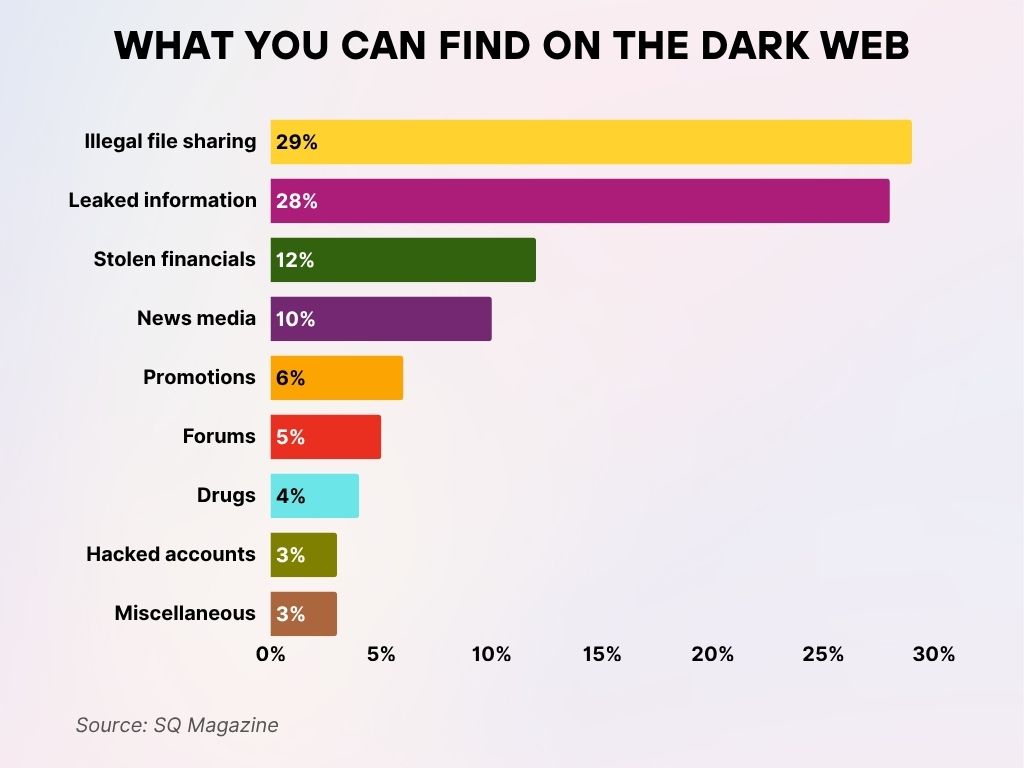
Notable Dark Web Data Breaches and Leaks
- In April 2025, a data breach of 18 million user credentials from a major US healthcare provider surfaced on dark web forums.
- A March 2025 breach of a Latin American e-commerce platform exposed 3.6 million credit card records.
- Hacktivist groups published over 11 gigabytes of internal law enforcement documents from a compromised European agency.
- Data from over 900,000 verified Coinbase accounts appeared in a January 2025 leak, raising security alarms.
- Breaches targeting smart home device manufacturers resulted in over 5 million IoT device logs being sold.
- Multiple credential-stuffing campaigns reused leaked info from 2024’s Uber, LastPass, and Ticketmaster incidents.
- The average price of breached databases has risen to $130 per 1,000 records.
- Vendors now offer subscription-based data access models, increasing buyer retention.
Where Funds Go After Leaving Darknet Markets
- Exchanges are the top destination, receiving 42.8% of funds leaving darknet markets, often used to cash out or convert illicit crypto.
- P2P exchanges account for 23.2%, showing the popularity of direct, anonymous trades among darknet users.
- Unnamed services take in 11.7%, reflecting the presence of unidentified platforms aiding in laundering or conversion.
- Darknet markets themselves retain 9.1% of the funds, either for internal circulation or vendor reinvestment.
- High-risk exchanges absorb 4.7%, often located in jurisdictions with weak regulatory oversight.
- Mixing services receive 4.0%, helping to obscure transaction trails and mask fund origins.
- Merchant services account for 3.7%, suggesting some illicit proceeds are directly spent on goods and services.
- Other minor destinations round out the rest, highlighting the complex flow and dispersion of darknet-related funds.
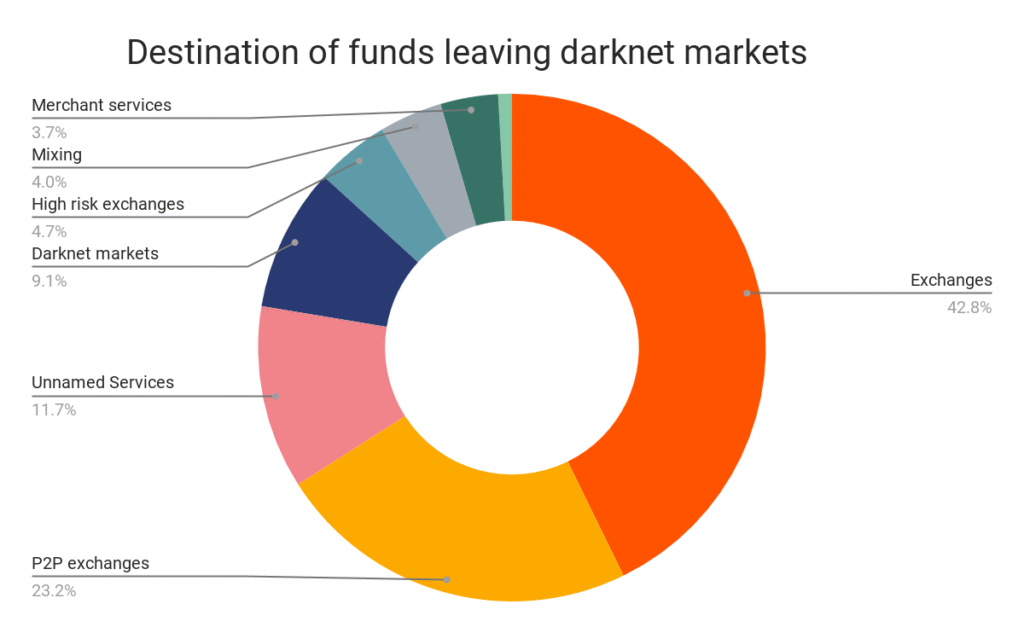
Recent Developments in Dark Web Monitoring
- In 2025, real-time dark web scanning tools have improved detection speed by 40% compared to 2024.
- AI-enhanced threat intelligence platforms are now deployed by 78% of Fortune 500 companies.
- Law enforcement agencies have increased investment in dark net crawler infrastructure, doubling from 2023.
- A global threat-sharing alliance between 14 countries was formalized in February 2025 to combat cross-border cybercrime.
- Dark web monitoring services now offer dashboard-style tools with predictive breach alerts.
- Monitoring has shifted from manual browsing to behavioral pattern detection via machine learning.
- New regulation proposals in the US and EU require a mandatory breach alert within 24 hours if dark web leaks are confirmed.
- Cyber insurance providers now factor in dark web exposure risk when calculating premiums.
Conclusion
As the digital underworld grows in complexity and reach, the dark web in 2025 is no longer just a fringe element; it’s an expanding infrastructure of illicit trade, advanced technology, and escalating threats. What used to be confined to shadowy corners now overlaps with mainstream platforms, and the line between privacy and crime continues to blur. With AI amplifying dark web operations and law enforcement racing to catch up, understanding these statistics isn’t just informative, it’s essential for security, policy, and awareness in a hyperconnected age.
Sources
- https://www.statista.com/topics/11491/dark-web/
- https://www.net25.com/news/dark-web-drug-market-busted-by-european-and-u-s-authorities
- https://socradar.io/top-10-dark-web-markets/
- https://www.statista.com/topics/569/e-commerce-and-the-dark-web/
- https://globalinitiative.net/analysis/digital-drug-revolution-online-markets-global-illicit-trade-ocindex/
- https://www.helpnetsecurity.com/2025/03/26/how-dark-web-works/








